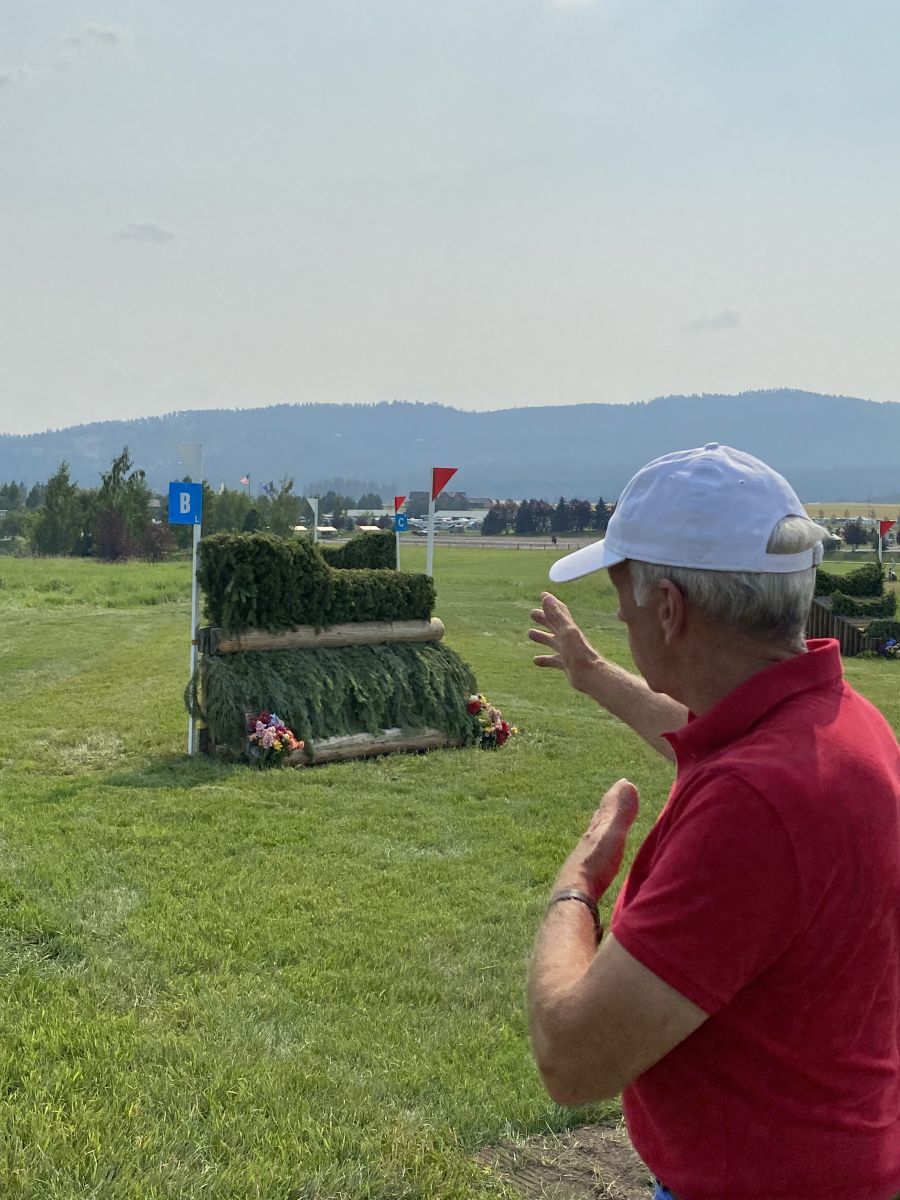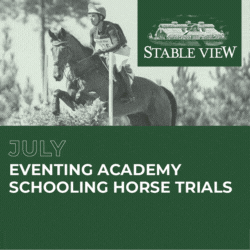
Course designer Ian Stark shows us the right line on the CCI4* track at Rebecca Farm. Photo by Erin Tomson.
This week’s coverage is brought to you by Kentucky Performance Products – and you can win some cool KPP swag and receive a discount on product all year long just by entering through this simple survey. Good luck!
The 2021 Event at Rebecca Farm kicked off to a great start today. Although the mountains surrounding the beautiful Flathead Valley in Montana are somewhat obscured by wildfire smoke, the air quality itself remained acceptable and partly cloudy skies offered a break from the ongoing heat wave. Day one was the dressage competition for 10 Novice divisions. With four arenas running, it was a busy day for the volunteers, organizers, and officials.
I had the unique opportunity to spend most of the day today with two of the officials. My morning was spent volunteering as a scribe for Valerie Pride of Maryland. Scribing is my favorite volunteer job because you gain amazing insight from experienced judges and there is nothing quite like seeing the dressage tests from the judges’ perspective! I learned precisely what the expectations are for the Novice level – the judges are looking for the horses to be freely forward with soft and consistent contact, and for the riders to be as accurate as possible. Riders should strive for accuracy at all levels, but it’s really a place to gain extra points at the Novice level because many riders are not as precise as they could be!
And what are the judges looking for in those stretchy trot circles and free walk? More stretch! Valerie’s comments today often included phrases such as “allow more stretch”, “maintain forward during stretch” (mostly in the trot), and “horse should stretch down as though grazing” (in the free walk). For me it was an excellent reminder that horses need to learn to be forward within relaxation in order to jump well – good basics on the flat are the foundation for good jumping!
Overall, Valerie was very positive, supportive of riders, and wanted everyone to be successful. She said she loves being asked to judge here in Montana. When I asked her what her favorite part about judging at Rebecca Farm is she spoke with enthusiasm, “It’s a destination event – a dream and goal for so many people to compete here. People have prepared so long and hard to get here, it’s fun to be here and be a part of something that’s so important to people at all levels. I love to watch the riders try so hard.” I completely agree – there is something incredibly unique and special about spending a week in Big Sky Country doing what we love.
After a great morning, my afternoon did not disappoint! I had the extremely rare opportunity to go on a tour of the 4*-L course with none other than Ian Stark – eventing legend and FEI cross country course designer. After spending 1.5 hours on a golf cart with Ian, I can tell you that he is incredibly nice, funny, and generous with his time and knowledge. He regaled us with tales of his own mistakes, such as galloping past the last fence and narrowly missing the finish line before expertly backtracking in the nick of time (50 time penalties are way better than a big fat E!).
Ian also explained the design, use, and purpose of frangible technology. When discussing the frangible fences he said, “I’m going to be quite controversial here… it’s a great idea, and I hate them with a vengeance.” He followed up this comment by saying that frangible fences are very useful when horses hit the jump straight on because they give way and can prevent a rotational fall. However, if the horse banks the jump (lands on top of a big table for example), and the jump gives way, that can actually cause a fall that wouldn’t otherwise happen.
“Anything that is going to avoid a nasty accident, of course it’s a great idea,” Ian added. He agrees, after attending a safety seminar, that the 11-point penalty for activating a frangible device is appropriate because riders should be cautious and should ride as well as possible (and if there was no penalty for activating the frangible device, riders would be more likely to take these jumps for granted and ride less carefully than perhaps they should).
Ian explained his approach to course design as being horse-friendly. His goal is to design jumps, lines, and use terrain in such a way that horses will understand the questions (if trained appropriately for the level) and should be successful if given a good ride. He fully admitted to finding some enjoyment in scaring the riders! Perhaps scaring is too strong a word – his goal is to make riders think and ride carefully, with precision.
His advice for being successful on his courses is to be prepared. He said there is absolutely no shame in dropping down a level if your previous run didn’t go as well as you’d hoped. Riders become too focused on moving up and competing at a high level that sometimes they attempt courses they or their horse are not ready for, and that’s asking for trouble. “The rider has got to be fit enough, the horse has got to be fit enough, and the preparation has got to be good. You can only push your luck to a certain limit. And you make your own luck – you make your own luck by being prepared.”
Ian also gave an apt reminder to give equal attention and effort to the first fence and the last fence on course – don’t get lazy and fall prey to “last jump syndrome!” While Ian’s advice and insight is certainly helpful for the riders heading out on the 4*-L and S this Saturday, it holds true for every single level. I know I will be thinking about these words of wisdom the next time I’m preparing my horse and myself for a competition.
The Event at Rebecca Farm: [Website] [Entries & Ride Times] [Schedule] [Volunteer] [Halt Cancer at X] [Live Stream] [Show Photographer] [EN’s Coverage]





















